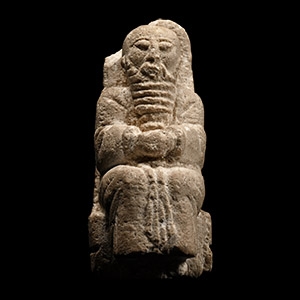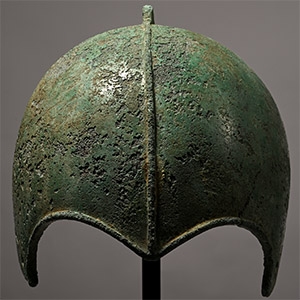Home > Auctions > 3 - 11 June 2025
Ancient Art, Antiquities, Books, Natural History & Coins
Ex collection of the late Mr S.M., London, UK, 1970-1990s.
This lot has been cleared against the Art Loss Register database, and is accompanied by an illustrated lot declaration signed by the Head of the Antiquities Department, Dr Raffaele D'Amato.
Ex West London, UK, collection, 1990s.
This lot has been cleared against the Art Loss Register database, and is accompanied by an illustrated lot declaration signed by the Head of the Antiquities Department, Dr Raffaele D'Amato.
See Vidale, M., Treasures from the Oxus: The Art and Civilisation of Central Asia, London, 2017, pp.44-51, figs.41-45, for a variety of stones and shapes.
Among the most iconic intercultural style objects are the so-called 'lock' or 'hand bag' weights. These were probably not weights at all, but were likely badges of high office, carried to indicate authority. Similar objects have been found throughout Mesopotamia, the islands of the Persian Gulf, on the Iranian steppe, as well as the Indus Valley.
Private collection, Switzerland, since the 1960s.
Accompanied by a copy of a previous two page illustrated cataloguing note.
Accompanied by a copy of an Art Loss Register certificate no.DAA0105.687.LL.
This lot has been checked against the Interpol Database of stolen works of art and is accompanied by a search certificate number no.12720-235460.
This lot has been cleared against the Art Loss Register database, and is accompanied by an illustrated lot declaration signed by the Head of the Antiquities Department, Dr Raffaele D'Amato.
Ex Mayfair, London, UK, collection, 1980s.
This lot has been checked against the Interpol Database of stolen works of art and is accompanied by a search certificate number no.12721-234904.
This lot has been cleared against the Art Loss Register database, and is accompanied by an illustrated lot declaration signed by the Head of the Antiquities Department, Dr Raffaele D'Amato.
with Christie's, New York, Interiors Sale, 14 January 2009, no.778.
Private collection, UK.
This lot has been cleared against the Art Loss Register database, and is accompanied by an illustrated lot declaration signed by the Head of the Antiquities Department, Dr Raffaele D'Amato.
Richard Ettinghausen (1906–1979), Princeton, New Jersey; acquired between the 1930s and 1960s.
Thence by descent to his son, Thomas A.D. Ettinghausen, and retained in the family residence, Princeton, New Jersey, until 2024.
Accompanied by a signed statement of provenance.
Accompanied by a copy of an IADAA Interpol search certificate.
Accompanied by a copy of a previous three page illustrated cataloguing note.
This lot has been cleared against the Art Loss Register database, and is accompanied by an illustrated lot declaration signed by the Head of the Antiquities Department, Dr Raffaele D'Amato.
Private collection formed in Europe in the 1980s.
Westminster collection, central London, UK.
Accompanied by an academic report by Dr Raffaele D’Amato.
This lot has been checked against the Interpol Database of stolen works of art and is accompanied by search certificate number no.12616-235608.
This lot has been cleared against the Art Loss Register database, and is accompanied by an illustrated lot declaration signed by the Head of the Antiquities Department, Dr Raffaele D'Amato.
Cf. Cernenko, E.V., The Scythians, 700-300 BC, London, 1983, p.11, pl.A1; Gorelik, M., Weapons of Ancient East, IV millennium BC-IV century BC, Saint Petersburg (2003) in Russian, colour plate 15, fig.3; plate XLII, nos.figs.29-30, 33-34, for identical types.
This war helmet, typical of the Caucasian Scythians, belongs to the so-called Kuban type according to B. Z. Rabinovich, named after the north Caucasian region where the majority of this type of helmets were found. The helmet is almost identical to the helmet found in the 6th century barrow at Kelermes (Stanitsa Kelermeskaya), and in fact many of such helmets have been found in the Northern Caucasus. The helmets were typical of the noblemen fighting on horseback with spear, javelins and especially with bow and arrows.
Acquired early 1990s.
Ex private American collection; thence by descent.
Private European collection since 1998.
Accompanied by an academic report by Dr Raffaele D'Amato.
This lot has been checked against the Interpol Database of stolen works of art and is accompanied by search certificate no.11573-199009.
This lot has been cleared against the Art Loss Register database, and is accompanied by an illustrated lot declaration signed by the Head of the Antiquities Department, Dr Raffaele D'Amato.
Cf. Coussin, P., Les Armes Romaines, Paris, 1926; Connolly, P., Greece and Rome at War, London, 1981; Fossati, I., Etruscan Armies, Milano, 1987, p.50, fig.4; Egg, M., 'Italische Helme mit krempe' in Antike Helme, RGZM Monographien 14, Mainz, 1988, pp.222ff., figs.1, 2, 34 and items 58-59, for type; Sekunda, N., and Northwood, S., Early Roman Armies, Oxford, 1995; Connolly, P., Greece and Rome at War, London, 2006; D'Amato, R., Salimbeti, A., The Etruscans, Oxford, 2018, pp.21ff. and pl.B3; D’Amato, R., Negin, A., Decorated Roman Armour, London, 2017, pp.8ff. and fig.2.
The ‘pot’ or ‘bell’ helmet, found in contexts as early as the 8th century coffer grave (ad arca) from the Esquiline (Rome) and other graves (Coussin, 1926, p.88, fig.23; Sekunda, Northwood,1995, p.6, grave 94) was made from a single piece of bronze, while later Italic variants were fashioned from jointed plates (Connolly, 1981, p.102, figs.2-2a; Egg, 1988, p.223, variant Vetulonia). The skull was somewhat spherical, with a flared rim: in some Etruscan and Italic specimens, this was rivetted for strength.
Ex Rabi Gallery, London, UK, 1980s.
From a private Surrey, UK, collection.
Accompanied by an academic report by Dr Raffaele D’Amato.
This lot has been checked against the Interpol Database of stolen works of art and is accompanied by search certificate number no.12606-234422.
This lot has been cleared against the Art Loss Register database, and is accompanied by an illustrated lot declaration signed by the Head of the Antiquities Department, Dr Raffaele D'Amato.
Cf. for similar examples, Christie's, The Axel Guttmann Collection of Ancient Arms and Armour, part 1, London, 2002, p.14, no.14; Gorelik, M., Weapons of Ancient East, IV millennium BC-IV century BC, Saint Petersburg (2003) in Russian, pl.VI, no.34, from Luristan; Christie's, The Axel Guttmann Collection of Ancient Arms and Armour, part 2, London, 2004, pp.23-24, no.23; Khorasani, M.M., Arms and Armour from Iran. The Bronze Age to the End of the Qajar Period, Tübingen, 2006, figs.43-44, for similar, from Marlik.
The now empty cavities of the handle were once filled with organic material.
Previously in a London, UK, collection, 1970s.
Ex Rabi Gallery 1991.
This lot is accompanied by an illustrated lot declaration signed by the Head of the Antiquities Department, Dr Raffaele D'Amato.
For a similar example see no.509, p.385, in Muscarell, Bronze and Iron: Ancient Near Eastern Artefacts in the Metropolitan Museum of Art; also cf. Gernez, G., L’armament en métal au Proche et Moyen-Orient: des origines a 1750 av. J.C., Paris, 2007, fig.2.47, type H5, for the type; and an almost example in Christie's New York, 5 December 2012, no.174 ($8,000-$12,000).
The ‘anchor’ axes belonged to a homogeneous type of axe, similar to the fenestrated axes, but displaying a different hafting method. The handle was inserted into a short cylindrical collar except at the back, where it extended to a width roughly equivalent to that of the blade. The two ends of the blade widened to form a concave face resting against the handle, thus ensuring a firm support. The edges of the fenestrelles were prominent and sometimes have decoration. At the back of the collar, there was always a spherical or flattened knob. The function of this knob can only be conjectured: it seems too small to serve as a counterweight, hence it was probably an element used to wind the handle's attachment cord.
From the collection of a gentleman, acquired on the London art market in the 1990s.
This lot is accompanied by an illustrated lot declaration signed by the Head of the Antiquities Department, Dr Raffaele D'Amato.
Cf. Röllig, W., ‘Onomastic and Palaeographic Considerations on Early Phoenician Arrow-Heads’ in Fantar, M. (ed.), Actes du IIIe Congrès International des Études Phéniciennes et Puniques, Tunis, 11-16 November 1991, Vol. II (1995), pp. 348-355; Elayi J., ‘Four New Inscribed Phoenician Arrowheads’ in SEL, 22, 2005, pp.33-45, pl.IV.
Private collection of a London gentleman, acquired between 1965–2020.
This lot has been checked against the Interpol Database of stolen works of art and is accompanied by search certificate number no.12619-235454.
This lot has been cleared against the Art Loss Register database, and is accompanied by an illustrated lot declaration signed by the Head of the Antiquities Department, Dr Raffaele D'Amato.
Cf. for parallels of the horse hilt from a machaira in Metropolitan Museum, inv. no. 2001.346; parallels for the blade in Head, D., The Achaemenid Persian Army, Stockport, 1992, p.28, letters d-e-g-h; for parallels of the muzzle, see the horse harness of Alexander the Great on the statuette of Napoli Archaeological Museum in Sekunda, N., The Army of Alexander the Great, London, 1984, p.35.
The akinakes was the short dagger of the Scythians and the Achaemenid Persians. Many examples of this characteristic weapon have been found in every corner of the Persian Empire. The hilt was often made of bronze, gold or gilded. It is visible in the hands of the Medes and Persians in the reliefs of Persepolis. These weapons, straight and double-edged, were about 35 cm long. The scabbards could be covered with gold, hung from the belt at the waist and, according to Herodotus, attached to the right thigh with a thong.
169 - 180 of 3130 LOTS


.jpg)
.jpg)
.jpg)
.jpg)
.jpg)



.jpg)

.jpg)



